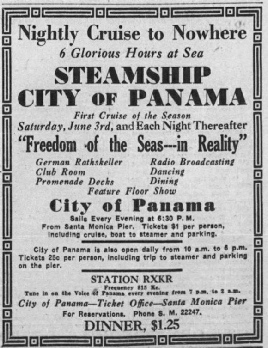© 2014-


RXKR - History
Offshore radio is usually thought of in the context of providing an alternative to the established state monopoly broadcasting systems, but the world's first true commercial offshore station was, surprisingly, located off the west coast of the USA during the early 1930s. Surprisingly because the US Government and authorities had adopted a much less restrictive approach to the development of radio broadcasting than most of their European contemporaries. This was partly because of the geographical size of the country, but largely due to the fact that the USA then, as now, valued most highly the right of its citizens to freedom of speech -
Initial reports of a planned offshore radio venture appeared in the International Radio News on 16th and 30th July 1932 indicating that a Los Angeles-
The organisers behind the project acquired a steamship, SS City of Panama, which had previously been fitted out as a casino and speakeasy. Such floating casinos were established in the 1920s and 30s to circumvent the anti-
The vessel was registered in Panama, ostensibly to act as a showboat promoting the attractions of that country as a holiday destination for US tourists. A radio station licence, with the call sign RXKR was also granted to the organisation by the Panamanian Government in the belief that broadcasts would be used to promote tourism and industry in their country. Under this licence the station was authorised to broadcast experimental, non-
Reaction to the granting of the licence by Panama was not favourable in the United States -
Panamanian response to the State Department's demands was dismissive. It considered that the US Government had no right to interfere with the activities of one of its legitimately registered vessels whilst in international waters. The Panamanian Consul in Los Angeles said the vessel was fully within its legal rights and had promised to operate as a "high class station" which would adhere to the standards established by the Federal Radio Commission (FRC) (forerunner of the Federal Communications Commission) for licensed land-
Unfortunately these assurances from the Panamanian Government were soon discredited by the actions of the offshore station's owners who violated most, if not all, of their licence conditions when station RXKR eventually came on the air on 3rd June 1933. Although authorised as a low power (500w-
discredited by the actions of the offshore station's owners who violated most, if not all, of their licence conditions when station RXKR eventually came on the air on 3rd June 1933. Although authorised as a low power (500w-
The City of Panama was the same floating speakeasy she had always been, but RXKR was transmitting with an estimated 5Kw of power and accepting advertising from companies in California. Commercials were being sold through an office established in Los Angeles and advertisers were reportedly paying as much as $1,500 per month. The FRC also claimed that some of the broadcasts were made while the vessel was anchored in Santa Monica harbour.
RXKR benefited from the fact that, at that time, there were a relatively small number of local commercial stations serving the west coast area. Advertisers were attracted to RXKR because of its enormous coverage area -
While RXKR was able to benefit commercially from the use of this high powered transmitter, its strong signal badly affected transmissions by legal stations throughout the west coast of Southern California, particularly those broadcasting between 810kHz and 820kHz. Many listeners in the Los Angeles area even gave up trying to hear any stations operating between 790 and 840 kHz while RXKR was transmitting.
Reception of RXKR was also reported from places as far afield as the east coast of the United States, Hawaii, Mexico and even north eastern Canada. Among stations known to have been affected were clear-


Click on picture to enlarge

History
Key Dates
Ship and Location
Technical
Staff





Back to RXKR

Back to America Gallery

Broadcast Magazine
15th June 1933
Advert in the Los Angeles Times. 1st June 1933 for the City of Panama ‘cruise to nowhere’ and the launch of RXKR
Click to enlarge

Honolulu Star Bulletin
1st July 1933
Programmes


Thanks to Mike Barraclough for allowing us to use the contemporary American press cuttings he researched about RXKR
